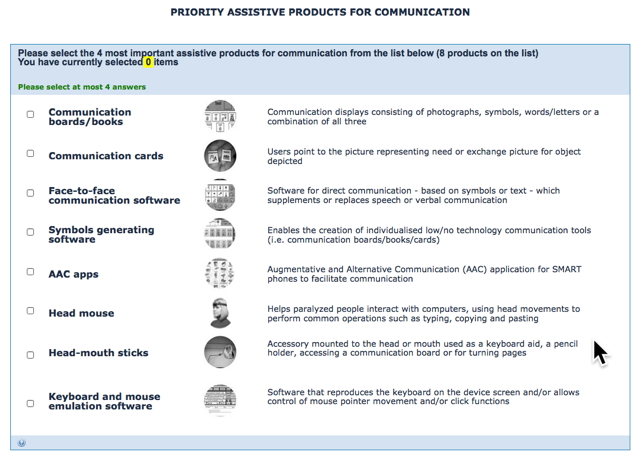 Newsletter: join thousands of other people
Newsletter: join thousands of other people
Once a month we'll send you an email with news, research and thoughts, as well as training courses and free webinars you may wish to attend.
Our websites:
Posted by Allan Wilson on the 26th February, 2016

The World Health Organisation (WHO) is attempting to compile a list of the "50 Most Priority Assistive Products", stating that "We need more than a billion assistive products now and 2 billion by 2050." Based on the apparent success of the Essential Medicines List, the WHO has made available a survey to allow people who use assistive products, their families and carers, and professionals advising them to have a say on priorities for assistive products. Presumably the WHO's eventual list will be based on the results of this survey.
The information accompanying the survey seems to be confusing - in some places they talk about "Assistive Technology", but in others they refer to the much broader field of "Assistive Products", which includes a wide range of aids that do not involve technology. When it comes to the products listed in the survey, the Assistive Products view seems to have won (though lots of technology is included). This is despite the flagship programme behind the initiative, Global Cooperation on Assistive Technology (GATE) having a clear emphasis on technology.
The Survey is divided into 6 questions, covering the following topics:
(Note that there is no question specifically relating to Dyslexia, one of the most common disabilities, though useful technology is included under other questions, for example Text-to-Speech software is included under Vision.)
Survey respondents are asked to select a specific number of priority items from a longer list. For example, in Mobility they can choose up to 16 products from a list of 32.
We don't have time and space to go through the whole Survey in detail so let's focus on Communication, a key area of CALL's work. The options are shown in the extract from the survey shown below.

We were immediately struck by the absence of dedicated communication aids from the list. iPads work well as communication devices for many people, but access issues can mean that a dedicated communication aid is the only communication solution for some people. There is no mention anywhere in the survey of the switches and interfaces that a small number of people need to allow access to a communication aid or computer. Where does an eye-gaze system fit into the possible priorities? It seems odd to include a Head Mouse, but not eye-gaze, given that our experience suggests that far more people are using eye-gaze. Of course, we would not wish to exclude the Head Mouse as it is the best solution for a small group of people.
From the structure of the survey, it looks as if they are planning to end up with four communication products on the list of Priority Assistive Products, but people with communication difficulties often need a total communication package, which might involve the following:
To take advantage of these products, they might also need a computer, an eye-gaze system, or switch access, but these are not included in the list of priority assistive products!
There are similar issues under all of the categories in the survey. In the Mobility section, for example, various orthoses are mentioned, but it is unlikely that all would make the final list, so if somebody required a Knee Ankle Foot Orthosis, but it wasn't included on the list, would they have to make do with just a Knee Orthosis?
At CALL we believe in providing individuals with the most appropriate assistive technology to meet their needs. We are certain that we will continue to do this to the best of our ability, whether or not the equipment needed is on any list provided by the WHO. But it is not hard to imagine a future in which some bureacrat decides that only equipment included on the WHO's list can be used.
It is clear that we have a lot of reservations about the thinking behind this survey, but we would encourage people to complete it, if only to help get a better picture of the world-wide need for assistive technology. Unfortunately, the deadline for completing the survey is 3rd March, so there isn't much time to do it.

4-week short study online course

Once a month we'll send you an email with news, research and thoughts, as well as training courses and free webinars you may wish to attend.
Our social media sites - YouTube, Twitter and Facebook